In my dual n-back post I reviewed the evidence for the IQ augmenting benefits of dual n-back training, taking a closer look at the Johns Hopkins University DNB study published this month. Compared to other types of brain training on the market, this 2017 review of all brain training studies up to now concludes in favour of the n-back:
“Just 20 h of practising the n-back task, besides enhancing performance on the task itself, also improves other cognitive processes.”
It even concludes that benefits are not only seen with working memory (Gwm), but also fluid intelligence (Gf) – our ability to see relationships & think abstractly:
“Far transfer effects on measures of fluid intelligence are small and observed typically after n-back training.”
To get a quantitative sense of the effectiveness of the training, below is a figure from another 2017 review of n-back studies. Unsurprisingly DNB training most improves performance on other n-back tasks. But it also augments IQ – working memory (Gw) and fluid intelligence (Gf) – as well as cognitive control. (The effect size of working memory here is equivalent in size to the effectiveness of popular antidepressants such as Prozac).
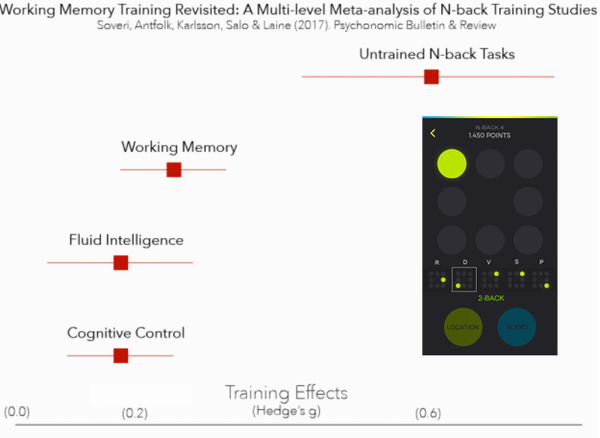
Gated Dual N-Back : Summary
How can we increase these transfer effects building on the mechanics of the dual n-back? And how can we do this in an evidence-based way that is motivated by the cognitive neuroscience?
This is where Gated Dual N-Back comes in.
My fellow cognitive neuroscience grad students from CMU – Prof. Randy O’Reilly (University of Colorado,
Boulder) & Prof. Tod Braver (Washington University) – have shown that higher level cognition has three components making up an integrated vertical axis from sensory input to goal-directed action (ref 1, ref 2, ref 3) .

In standard dual n-back and varieties such as the quad n-back, only the input gating and maintenance components are trained – but not output gating. In gated DNB brain training each component is separately targeted in full vertical integration IQ augmentation. Gated DNB training is fully realized into the latest i3 Mindware release.
Gated Dual N-Back : The Architecture
1. Input Gating
Intelligence starts with attention flexibility and focus. And we attend to something useful we open an ‘input gate’ through which information flows into the working memory system. For instance, when you are listening carefully to someone for instructions, you have to focus on what they are saying – not everything else that is going on around you. The instructions have to replace what you were thinking about before. This is working memory updating, and the information is stored in the pre-frontal cortex (PFC).
Professor Tod Braver has shown that the input gate is opened via dopamine signals from the basal ganglia of the brain to the pre-frontal cortex in the frontal lobes where the information is updated (ref).
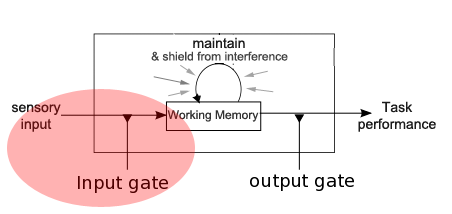
2. Maintenance / Interference Control
In our listening to instructions example, when your WM’s input gate is closed your pre-frontal cortex maintains the instructions you’ve been given in your ‘mental workspace’ that you will use for performing some task. And while you are processing these instructions in WM, you don’t want distractions interfering with what you need to do. By focusing you have to buffer the information you need – and this is interference control.
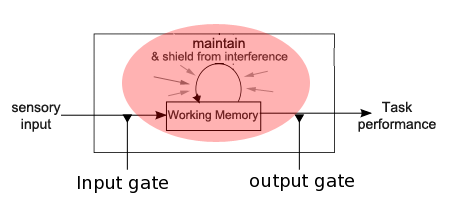
Evidence suggests WM maintenance and interference control depends on gamma wave synchronization in the brain’s hippocampus – where circuits of neurons all oscillate together at around 40 Hz while holding information in our mental workspace (ref).
3. Output Gating
Not all information that you are keeping ‘online’ in your ‘mental workspace’ may be relevant to what you are currently trying to do. For instance, you need to apply the instructions you’ve just been told, just one step at a time. Or you may need to use certain combinations of information in WM to make a decision, but not other combinations. This kind of selection and management of workspace information for ‘downstream’ processing depends on output gating.
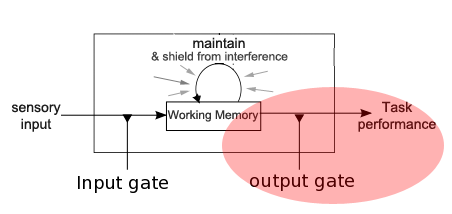
Studies have shown that WM output gating, like input gating, depends on pre-frontal cortex circuitry (ref).
Output gating is important not only for intelligent action selection, but is particularly important, relative to input gating, for the application and learning of abstract, higher order rules (ref, ref, ref) – precisely what is needed for learning and the development of expertise. It is in fact needed for all these IQ-related abilities:
- Applying complex rules
- Decision making
- Planning
- Learning and generalization
- Complex reasoning
Gated Dual N-Back : How It Works
Input and output gated dual-n-back training is implemented in the new i3 2G+ releases.
Input Gating Training
All our games train input gating, although our latest 2G and 2G+ games further augment input gate training, requiring the flexible switching between four streams of information rather than the standard two (audio and visual) in the DNB. The 2G and 2G+ game options are similar to quad dual n-back training if you are familiar with that.
Maintenance / Interference Control Training
Interference control training – augmenting gamma synchrony in the hippocampus – is engineered into our brain training apps through a carefully designed sequencing of the n-back stimuli. Essentially, the sequence of stimuli often repeats itself before the target is presented, and the overlap is difficult to resolve. Brain imaging studies have shown that interference control underlies the relationship between fluid intelligence and working memory capacity (ref). For this reason, all the DNB games we implement build in more interference control training than standard dual n-backs. Interference control training is also central in the Stroop’ n-back game, found in the 2G+ game mode in our new releases
Output Gating Training
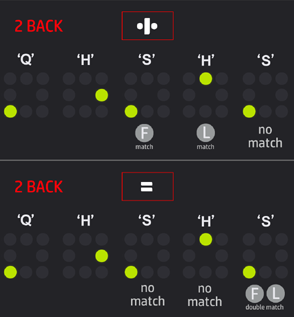
Brain training that targets prefrontal cortex output gating is a big step up from classic dual n-back training. We implement this in the 1G, 2G and 2G+ game options, through OR, AND and XOR ‘logic-gating’. With output gating, you have to modify normal dual n-back responses depending on whether the item matches occur alone or together. It is a simple, intuitive concept, and enables training with full vertical integration – from input gating, to maintenance, to intelligent learning and action selection.
For those already familiar with the DNB, the concept is shown below. At the top you must respond when there is a disjoint match – i.e. you do not respond when both modalities match at the same time. At the bottom you only respond when both modalities match at the same time, but not when either of them matches on its own.
2G+ : Vertical and Horizontal Integration
2G+ training (the most challenging gated DNB option in our new releases) combines full vertical integration with horizontal integration. Horizontal integration doesn’t work on the sensory input > action (vertical) axis, but on the information content and task variety (horizontal) axis. 2G+ works with different types of information content, including non-categorical, Stroop and emotional stimuli.
Exec Summary
Classic dual n-back trains input gating and WM maintenance/interference control on the vertical axis. Previous IQ Mindware apps augmented classic dual n-back with greater interference control training. Other n-back variants on the market such as quad N-Back enhance input gating training. But no DNB games on the market train output gating, the component of our cognitive architecture most associated with IQ and learning. Our latest i3 release specifically trains output gating as well as the input and maintenance levels of the axis for full vertical integration. They also train diverse task-types and information modes in the 2G+ game option for horizontal integration. This is why gated dual n-back training results in greater ‘far transfer’ and IQ augmentation.


Do you know where I can acquire n-back software that matches the Hopkins version?
Yes, our software implements the Hopkins version in the ‘classic DNB’ mode.